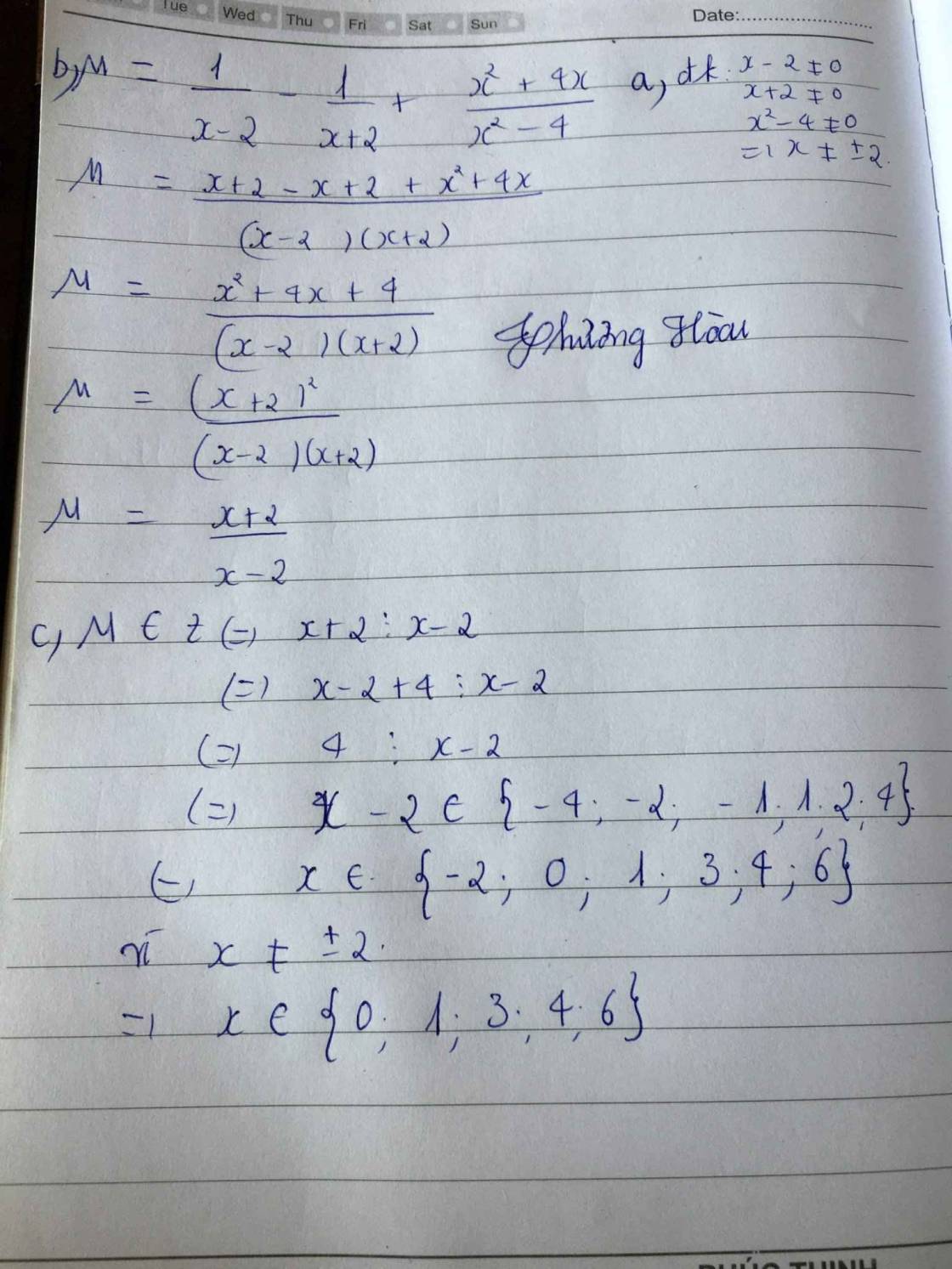Hãy nhập câu hỏi của bạn vào đây, nếu là tài khoản VIP, bạn sẽ được ưu tiên trả lời.


a: Khi x=5 thì A=5/(5+3)=5/8
b: \(C=A+B=\dfrac{x}{x+3}+\dfrac{2}{x-3}+\dfrac{3-5x}{x^2-9}\)
\(=\dfrac{x^2-3x+2x+6+3-5x}{\left(x-3\right)\left(x+3\right)}=\dfrac{x^2-6x+9}{\left(x-3\right)\left(x+3\right)}=\dfrac{x-3}{x+3}\)
c: Để C nguyên thì x+3-6 chia hết cho x+3
=>\(x+3\in\left\{1;-1;2;-2;3;-3;6;-6\right\}\)
=>\(x\in\left\{-2;-4;-1;-5;0;-6;-9\right\}\)

a)
\(ĐKXĐ:\left\{{}\begin{matrix}x-2\ne0\\x+2\ne0\\x^2-4\ne0\end{matrix}\right.< =>\left\{{}\begin{matrix}x\ne2\\x\ne-2\end{matrix}\right.\)
b)
\(\dfrac{1}{x-2}-\dfrac{1}{x+2}+\dfrac{x^2+4x}{x^2-4}\)
\(=\dfrac{1}{x-2}-\dfrac{1}{x+2}+\dfrac{x\left(x+4\right)}{\left(x-2\right)\left(x+2\right)}\)
\(=\dfrac{x+2}{\left(x-2\right)\left(x+2\right)}-\dfrac{x-2}{\left(x-2\right)\left(x+2\right)}+\dfrac{x\left(x+4\right)}{\left(x-2\right)\left(x+2\right)}\)
\(=\dfrac{x+2-x+2+x^2+4x}{\left(x-2\right)\left(x+2\right)}\)
\(=\dfrac{x^2+4x+4}{\left(x-2\right)\left(x+2\right)}\\ =\dfrac{\left(x+2\right)^2}{\left(x-2\right)\left(x+2\right)}\\ =\dfrac{x+2}{x-2}\)
c)
\(\dfrac{x+2}{x-2}=\dfrac{x-2+4}{x-2}=\dfrac{x-2}{x-2}+\dfrac{4}{x-2}=1+\dfrac{4}{x-2}\)
vậy M nhận giá trị nguyên thì 4⋮x-2
=> x-2 thuộc ước của 4
\(Ư\left(4\right)\in\left\{-1;1;-2;2;;4;-4\right\}\)
ta có bảng sau
| x-2 | -1 | 1 | -2 | 2 | 4 | -4 |
| x | 1(tm) | 3(tm) | 0(tm) | 4(tm) | 6(tm | -2(loại) |

Bài 17.Cho phân thức: A=2x-1/x^2-x
a. Tìm điều kiện để giá trị của phân thức được xác định.
x^2 - x # 0
<=> x ( x - 1 ) # 0
<=> x # 0
<=> x -1 # 0 => x # 1
b. Tính giá trị của phân thức khi x = 0 và khi x = 3.
Nếu x = 0 thì phân thức ko xác định
Nếu x = 3 thì
2.3 - 1 / 3^2 - 3
= 5/6

a) ĐKXĐ: \(\hept{\begin{cases}x+2\ne0\\x^2-4\ne0\\2-x\ne0\end{cases}}\) => \(\hept{\begin{cases}x\ne-2\\x\ne\pm2\\x\ne2\end{cases}}\) => \(x\ne\pm2\)
Ta có:Q = \(\frac{x-1}{x+2}+\frac{4x+4}{x^2-4}+\frac{3}{2-x}\)
Q = \(\frac{\left(x-1\right)\left(x-2\right)}{\left(x+2\right)\left(x-2\right)}+\frac{4x+4}{\left(x-2\right)\left(x+2\right)}-\frac{3\left(x+2\right)}{\left(x-2\right)\left(x+2\right)}\)
Q = \(\frac{x^2-2x-x+2+4x+4-3x-6}{\left(x+2\right)\left(x-2\right)}\)
Q = \(\frac{x^2-2x}{\left(x+2\right)\left(x-2\right)}=\frac{x\left(x-2\right)}{\left(x+2\right)\left(x-2\right)}=\frac{x}{x+2}\)
b) ĐKXĐ P: x - 3 \(\ne\)0 => x \(\ne\)3
Ta có: P = 3 => \(\frac{x+2}{x-3}=3\)
=> x + 2 = 3(x - 3)
=> x + 2 = 3x - 9
=> x - 3x = -9 - 2
=> -2x = -11
=> x = 11/2 (tm)
Với x = 11/2 thay vào Q => Q = \(\frac{\frac{11}{2}}{\frac{11}{2}+2}=\frac{11}{15}\)
c) Với x \(\ne\)\(\pm\)2; x \(\ne\)3
Ta có: M = PQ = \(\frac{x+2}{x-3}\cdot\frac{x}{x+2}=\frac{x}{x-3}=\frac{x-3+3}{x-3}=1+\frac{3}{x-3}\)
Để M \(\in\)Z <=> 3 \(⋮\)x - 3
=> x - 3 \(\in\)Ư(3) = {1; -1; 3; -3}
Lập bảng:
| x - 3 | 1 | -1 | 3 | -3 |
| x | 4 | 2 (ktm) | 6 | 0 |
Vậy ...

BÀI 1:
a) \(ĐKXĐ:\) \(x-3\)\(\ne\)\(0\)
\(\Leftrightarrow\)\(x\)\(\ne\)\(3\)
b) \(A=\frac{x^3-3x^2+4x-1}{x-3}\)
\(=\frac{\left(x^3-3x^2\right)+\left(4x-12\right)+11}{x-3}\)
\(=\frac{x^2\left(x-3\right)+4\left(x-3\right)+11}{x-3}\)
\(=x^2+4+\frac{11}{x-3}\)
Để \(A\)có giá trị nguyên thì \(\frac{11}{x-3}\)có giá trị nguyên
hay \(x-3\)\(\notinƯ\left(11\right)=\left\{\pm1;\pm11\right\}\)
Ta lập bảng sau
\(x-3\) \(-11\) \(-1\) \(1\) \(11\)
\(x\) \(-8\) \(2\) \(4\) \(14\)
Vậy....

a: ĐKXĐ: \(x\notin\left\{-\dfrac{1}{2};\dfrac{1}{2};-2\right\}\)
b: \(B=\dfrac{4x^2+4x+1-4-4x^2+4x-1}{\left(2x-1\right)\left(2x+1\right)}\cdot\dfrac{2x+1}{x+2}\)
\(=\dfrac{8x-4}{2x-1}\cdot\dfrac{1}{x+2}=\dfrac{4}{x+2}\)

Chắc là \(M=\dfrac{4x+1}{x^2+3}\) đúng không nhỉ?
\(M=\dfrac{-\left(x^2+3\right)+x^2+4x+4}{x^2+3}=-1+\dfrac{\left(x+2\right)^2}{x^2+3}\ge-1\)
\(M=\dfrac{12x+3}{3\left(x^2+3\right)}=\dfrac{4\left(x^2+3\right)-4x^2+12x-9}{3\left(x^2+3\right)}=\dfrac{4}{3}-\dfrac{\left(2x-3\right)^2}{3\left(x^2+3\right)}\le\dfrac{4}{3}\)
\(\Rightarrow-1\le M\le\dfrac{4}{3}\)
Mà M nguyên \(\Rightarrow M=\left\{-1;0;1\right\}\)
- Với \(M=-1\Rightarrow\dfrac{4x+1}{x^2+3}=-1\Rightarrow\left(x+2\right)^2=0\Rightarrow x=-2\)
- Với \(M=0\Rightarrow\dfrac{4x+1}{x^2+3}=0\Rightarrow4x+1=0\Rightarrow x=-\dfrac{1}{4}\)
- Với \(M=1\Rightarrow\dfrac{4x+1}{x^2+3}=1\Leftrightarrow x^2-4x+2=0\Rightarrow x=2\pm\sqrt{2}\)
Vậy \(x=\left\{-2;-\dfrac{1}{4};2-\sqrt{2};2+\sqrt{2}\right\}\) thì M nguyên